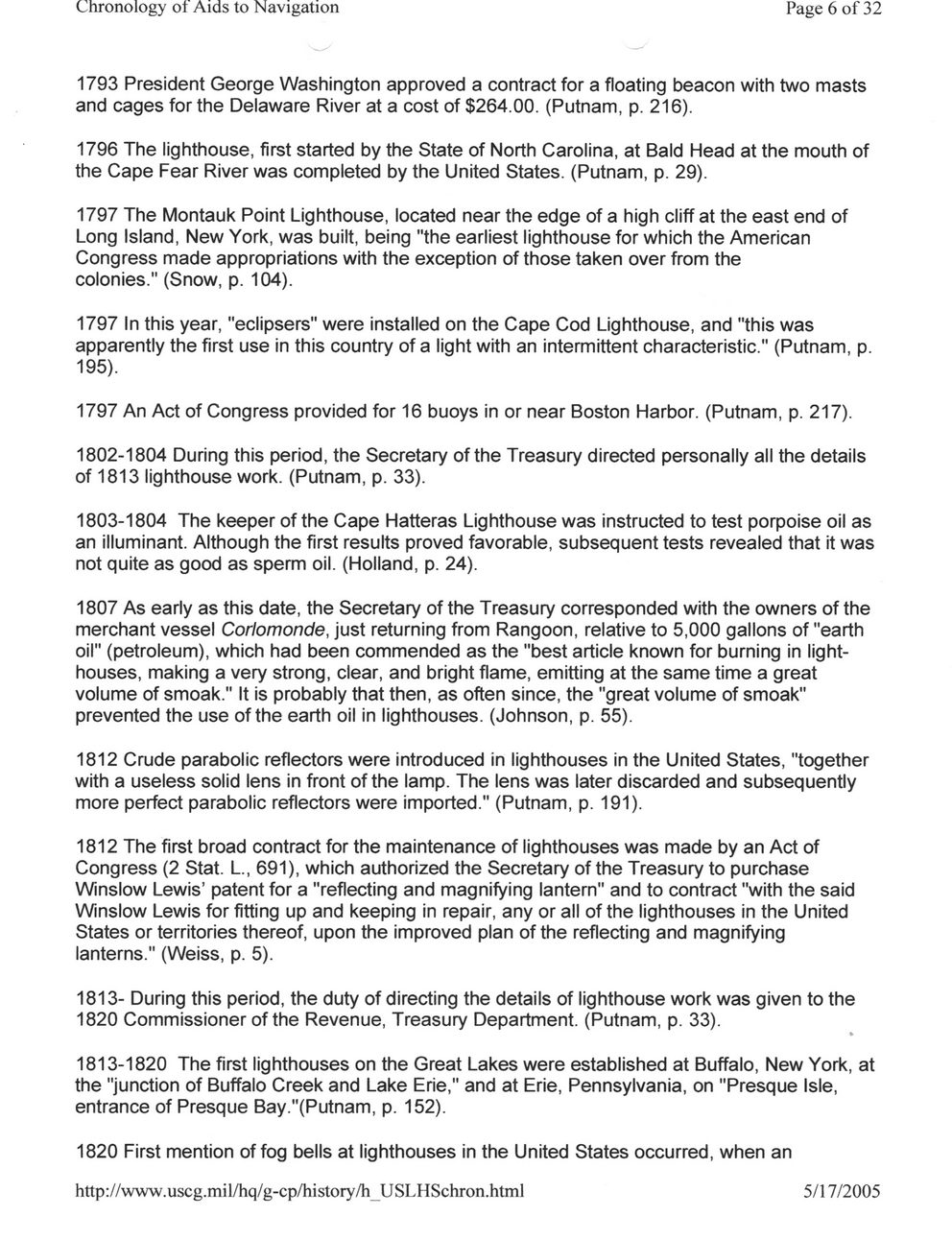This text was obtained via automated optical character recognition.
It has not been edited and may therefore contain several errors.
Chronology of Aids to Navigation Page 6 of 32 1793 President George Washington approved a contract for a floating beacon with two masts and cages for the Delaware River at a cost of $264.00. (Putnam, p. 216). 1796 The lighthouse, first started by the State of North Carolina, at Bald Head at the mouth of the Cape Fear River was completed by the United States. (Putnam, p. 29). 1797 The Montauk Point Lighthouse, located near the edge of a high cliff at the east end of Long Island, New York, was built, being "the earliest lighthouse for which the American Congress made appropriations with the exception of those taken over from the colonies." (Snow, p. 104). 1797 In this year, "eclipsers" were installed on the Cape Cod Lighthouse, and "this was apparently the first use in this country of a light with an intermittent characteristic." (Putnam, p. 195). 1797 An Act of Congress provided for 16 buoys in or near Boston Harbor. (Putnam, p. 217). 1802-1804 During this period, the Secretary of the Treasury directed personally all the details of 1813 lighthouse work. (Putnam, p. 33). 1803-1804 The keeper of the Cape Hatteras Lighthouse was instructed to test porpoise oil as an illuminant. Although the first results proved favorable, subsequent tests revealed that it was not quite as good as sperm oil. (Holland, p. 24). 1807 As early as this date, the Secretary of the Treasury corresponded with the owners of the merchant vessel Corlomonde, just returning from Rangoon, relative to 5,000 gallons of "earth oil" (petroleum), which had been commended as the "best article known for burning in lighthouses, making a very strong, clear, and bright flame, emitting at the same time a great volume of smoak." It is probably that then, as often since, the "great volume of smoak" prevented the use of the earth oil in lighthouses. (Johnson, p. 55). 1812 Crude parabolic reflectors were introduced in lighthouses in the United States, "together with a useless solid lens in front of the lamp. The lens was later discarded and subsequently more perfect parabolic reflectors were imported." (Putnam, p. 191). 1812 The first broad contract for the maintenance of lighthouses was made by an Act of Congress (2 Stat. L., 691), which authorized the Secretary of the Treasury to purchase Winslow Lewis’ patent for a "reflecting and magnifying lantern" and to contract "with the said Winslow Lewis for fitting up and keeping in repair, any or all of the lighthouses in the United States or territories thereof, upon the improved plan of the reflecting and magnifying lanterns." (Weiss, p. 5). 1813- During this period, the duty of directing the details of lighthouse work was given to the 1820 Commissioner of the Revenue, Treasury Department. (Putnam, p. 33). 1813-1820 The first lighthouses on the Great Lakes were established at Buffalo, New York, at the "junction of Buffalo Creek and Lake Erie," and at Erie, Pennsylvania, on "Presque Isle, entrance of Presque Bay."(Putnam, p. 152). 1820 First mention of fog bells at lighthouses in the United States occurred, when an http://www.uscg.mil/hq/g-cp/history/h_USLHSchron.html 5/17/2005

Lighthouses Chronology-of-Aids-to-Navigation-(06)